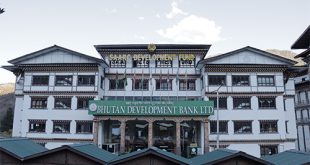Bhutan’s first reservoir project will create a 17 km long lake
The Druk Green Power Corporation (DGPC) will take up construction of the 180 MW Bunakha Reservoir project in 2026 on its own.
DGPC is in the process of negotiating a USD 450 million (mn) or a Nu 39.681 billion (bn) (1 USD= Nu 88.18) loan from the Asian Development Bank (ADB) for the project.
The project may be small in terms of MW but it will generate a lot of power, not only for itself but also down stream projects like 336 MW Chukha, 1020 MW Tala and the upcoming 570 MW Wangchu project.
More crucially, this will be especially be useful in the winter months when Bhutan is in need for power as rivers become smaller.
This will be possible because the project is Bhutan’s first reservoir project, which will dam and create a narrow but 17.25 km long lake from Bunakha all the way to Damchu.
The project may be small in size but it will generate a substantial 1600 million units every year of which 45 percent will be generated at Bunakha and 55 percent in downstream projects of Chukha, Tala and Wangchu.
Its role will not be noticeable in summer or monsoon months as a swollen river will generate enough power for all projects on the river, but it will play a key role in winter when the lake behind it will be used to generate power strategically.
The aim will not just be for winter generation, but it will aim to generate peak power or power at the time when electricity demand and rates are highest in India.
Given how Bunakha will impact Chukha, Tala and Wangchu, the proposal is that these three downstream projects either share the cost of the project or that the additional energy generated by them due to Bunakha be accounted to Bunakha.
A big plus of the Bunakha reservoir is the tourism potential, as a 17.25 km long lake can be used for boating and other activities, as Bhutan does not have a lake of such size and it would be especially attractive given its closeness to Paro, Thimphu and even Phuentsholing.
DGPC will not develop any tourism facilities but that will be left to the Tourism Department and tour operators, hoteliers and other potential investors.
Background
The Bunakha project was originally meant to be a joint venture with PSU company Tehri Hydro Development Corporation (THDC) but it could not happen as another PSU Satluj Jal Vidyut Nigam (SJVN) which was the original partner for the downstream Wangchu declined to share the downstream costs of Nu 1.17 bn for Bunakha as Wangchu would benefit from the Bunakha reservoir. As per the 2014 cost sharing agreement since Wangchu had to pay around Nu 2.358 bn to Bunakha for additional power gains, SJVN’s share was Nu 1.17 bn.
Chukha in 2014 was to pay around Nu 3.235 bn, Tala around Nu 6.190 bn and DGPC Nu 1.17 bn for its 50 percent share of the Wangchu project. This would go up once interest during construction and cost escalations are included for Bunakha.
Otherwise, the Bunakha project was not seen as being viable, as even with such cost sharing, its power generation would come to around Nu 5.12 per unit in 2016 which will be higher now.
The DPR for the project had received approval in 2014.
The approximate project cost in 2014 was Nu 29 bn which has increased to almost Nu 40 bn now due to inflation.
For Bhutan, Bunakha makes a lot of long-term sense, as it would be the only reservoir project on the Wangchu River with much more water storage capacity then the run of the river projects. In addition to benefitting the three projects, it would provide more energy security in winter, and also be able to charge higher rates for peak power rates and also be part of a lucrative renewable energy mix, backing up sudden shortages from solar and wind power projects in India.
Back in 2014 at the then tariff rates, because of Bunakha, Chukha would gain an additional Nu 575 mn in revenue a year, Tala would gain Nu 972 mn a year and Wangchu would gain Nu 420 mn (at Chukha tariff rates). These would be more now as tariff rates have gone up since 2014.
However, given that the above projects would have to invest in Bunakha’s construction the average tariff for the addition power generated due to Bunakha in 2014 was calculated at around Nu 3.72 per unit.
 The Bhutanese Leading the way.
The Bhutanese Leading the way.




